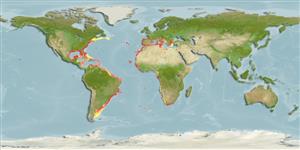Teleostei (teleosts) >
Scombriformes (Mackerels) >
Scombridae (Mackerels, tunas, bonitos) > Scombrinae
Etymology: Scomber: Greek, skombros = tunny or mackerel, 1623 (Ref. 45335).
More on author: Gmelin.
Environment: milieu / climate zone / depth range / distribution range
Ecology
Marine; brackish; pelagic-neritic. Temperate; 46°N - 65°S, 98°W - 42°E
Atlantic Ocean. Warm water; eastern and western coasts, including the Mediterranean and southern Black Sea. Replaced by Scomber japonicus in the Indo-Pacific.
Length at first maturity / Size / Weight / Age
Maturity: Lm 21.3 range ? - ? cm
Max length : 55.0 cm TL male/unsexed; (Ref. 121850)
Adults and juveniles feed mainly on zooplankton, with relative importance of larger organisms such as cephalopods, crustaceans and small pelagic fish increases with the size of individuals. Caught mostly in purse seine and pelagic trawl fisheries which target sardine and/or anchovy. Usually a by-catch but when availability of target species is low, this species provided an alternative income (Ref. 121850)
Collette, B.B., 1999. Mackerels, molecules, and morphology. p. 149-164. In B. Séret and J.-Y. Sire (eds.) Proc. 5th Indo-Pac. Fish Conf., Noumea, Paris. (Ref. 33246)
IUCN Red List Status (Ref. 130435)
Threat to humans
Harmless
Human uses
Fisheries: minor commercial
Tools
Warning: mysqli::__construct(): (HY000/1040): Too many connections in /var/www/html/includes/speciessummary.lib.php on line 2414
Can't connect to MySQL database fbquizv2. Errorcode: Too many connections
